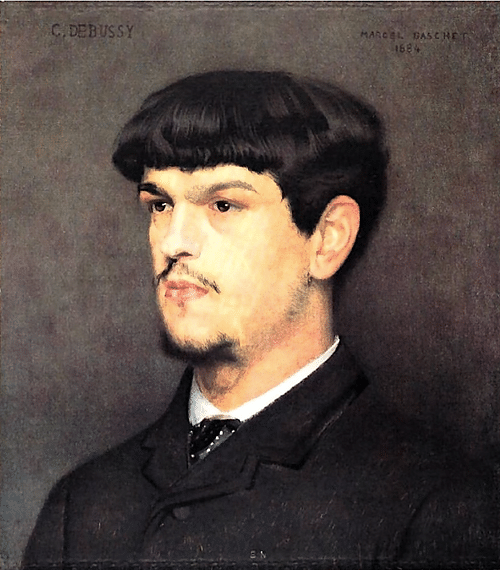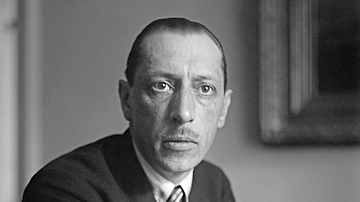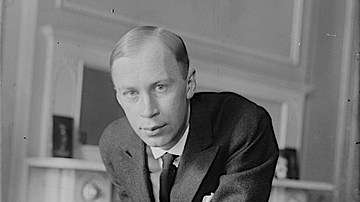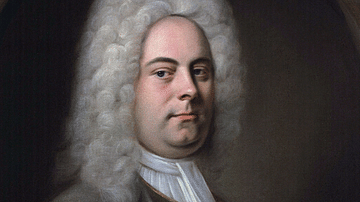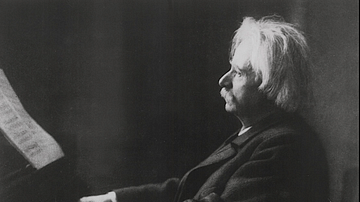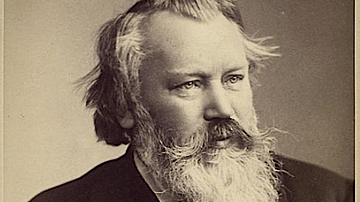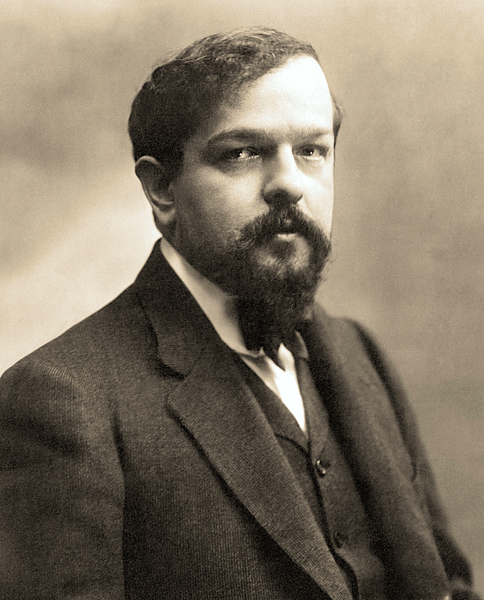
Claude Debussy (1862-1918) was a French composer most famous for his piano and orchestral music. Works like Clair de Lune have become piano standards while La Mer, with its unusual use of instruments and impressionistic use of waves of sounds instead of melodies, broke the mould of convention and ushered in the innovative music of modernism in the 20th century.
Early Life
Claude Achille Debussy was born on 22 August 1862 in St Germain-en-Laye, now a western suburb of Paris. Claude's father, Manuel-Achille, owned a china shop before moving on to other ways of earning a living, and he wanted his son to go to sea, which meant he was not very interested in providing him with a formal education. Fortunately, Claude learnt to play the piano from Madame Mauté, (possibly) a former pupil of Frédéric Chopin (1810-1849) and while he was staying with his Aunt Clémentine in Cannes in southern France where he often spent his holidays. Claude was soon accomplished enough to enrol in the Paris Conservatoire in October 1872 when he was ten years old. Impressing with his ability to compose and improvise, Claude, nevertheless, troubled his teachers with his complete disregard for music conventions. The young pianist preferred to follow only one rule: "mon plaisir" ("my pleasure"). By 1884, Claude had won several prizes but non greater than the prestigious Prix de Rome, his entry being L'enfant prodigue (The Prodigal Son), a cantata. Part of the prize was money to study in Rome. Returning to France in February 1887, he came to greatly admire the work of Richard Wagner (1813-1883), even visiting Bayreuth in Bavaria in 1888, the town where many of Wagner's operas were premiered.
Musical Style
In his mature years, Debussy moved far away from the Wagnerian tradition that cast its powerful shadow over music; he by then described Wagner's body of work as "a beautiful sunset that was mistaken for a dawn" (Thompson, 186). Debussy was a composer of modern music and his mature work was in complete contrast to the Romantic music of Wagner. The French composer once described his own style as "flexible and adaptable to fantasies and dreams" (Thompson, 187). In his work, Debussy was particularly influenced by Modest Musorgsky (1839-1881), by medieval music, and by Javanese music, which he encountered in Paris performed by touring companies. Most of the great composers and their obsession with form bored Debussy, who, in contrast, viewed music solely as "made up of colors and rhythms. The rest is a lot of humbug invented by frigid imbeciles" (Schonberg, 524).
In addition, Debussy was innovative not only with his playing of the piano keys but the pedals, too. The composer's objective was to make the piano an "instrument without hammers" (Schonberg, 531). This was noted by Alfredo Casella, who, observing Debussy play, remarked: "One had the impression that he was actually playing on the strings of the instrument, without the mechanical aid of keys and hammers. He used the pedals as nobody else ever did. The result was pure poetry" (ibid, 530).
Debussy was inspired by artists in other fields, notably symbolist poets and impressionist painters. He encountered these artists and their work in Paris' Montmartre, Debussy having taken an apartment there in the 1890s. He composed musical scores for poems by fellow-Frenchman Paul Verlaine (1844-1896). Debussy's 1889 La damoiselle élue (The Blessed Damozel), a cantata, was inspired by a poem by Dante Gabriel Rossetti (1828-1882) and was a success with the public when premiered in April 1893. Like the painters of the new impressionism (last quarter of the 19th century), who used short, quick, and identifiable brush strokes to capture the transient effects of light, so Debussy used short waves of sounds to create his effects on the listener (although he himself disliked being termed an 'impressionist' musician).
The inspiration of Eastern gamelan music was its minimalist use of instruments and sounds. Experiments in form by Debussy included "new piano sonorities, and with a scale based on whole tones, without a firm key centre" (Thompson, 187). Debussy's innovative style did not always gain admirers. Fellow French composer César Franck (1822-1890) memorably described Debussy's work as "music on the points of needles" (Thompson, 186).
Character & Family
Debussy liked the finer things in life, even if his personal finances were very often in a poor state. The music historian C. Schonberg gives the following summary of Debussy's character:
He had to surround himself with fine prints and books. He was a gourmet with a notable appetite for caviar. He dressed to the point of dandyism, complete with carefully selected cravat, cape, and broad-brimmed hat. He knew exactly what he wanted from life and he took it, ignoring the rest…[he was] a complicated and reserved man, one whose shell was hard to penetrate. He had few friends and fewer intimates…He always was abnormally touchy – quick to take offense, sensitive to the point of mania…he hated to appear in public, hated to conduct, hated to play the piano at concert. He preferred cats to people, and was never without one or more Siamese cats.
(520-9)
When he was 18, Debussy fell in love with the much older soprano singer Marie-Blanche Vasnier. Infatuated, the young composer wrote many songs for his lover. In the late 1880s, Debussy had an affair with a married woman. While in Montmartre, his regular girlfriend was Gabrielle Dupont whose origins and profession remain a mystery, such was Debussy's aversion to talking to others about his private life. The lack of money strained the relationship, and the couple split up in 1898. In October 1899, Debussy married the artist's model Rosalie (Lily) Texier, but this relationship was not destined to last long. In July 1904, Debussy ran away with the wife of a banker, the singer Emma Bardac (1862-1934). Both Gabrielle and Rosalie shot themselves when Debussy left them (the former survived the suicide attempt). Meanwhile, Debussy and Bardac stayed in Jersey where the composer wrote his L'île joyeuse. Returning to Paris to live in the avenue Bois de Boulogne, Debussy and Bardac had a daughter in October 1905, Claude-Emma, aka Chouchou. Debussy and Bardac married on 20 January 1908.
Impressionist-Symbolist Works
One of Debussy's most famous pieces, Clair de lune (Moonlight), comes from his Suite bergamasque, composed in 1890. Other works for piano in this period include the Fêtes galantes (1891-1904) and the Pour le piano suite (1894-1904). Nocturnes, another celebrated Debussy work, is an orchestral triptych with the movements given the following titles: Nuages (Clouds), Fêtes (Festivals), and Sirènes (Sirens). Respectively, the three parts represent a cloudy day by the River Seine, a carnival in Paris with a brass band, and the singing of mermaids. The Nocturnes trio was composed between 1897 and 1899. Other impressionist-like works include Jardins sous la pluie (Gardens in the Rain) and Soirée dans Grenade (Evening in Grenada). String instruments were not neglected with the 1893 String Quartet and the innovative 1894 orchestral piece Prélude à L'après-midi d'un faune (Prelude to The Afternoon of a Faun), which was his first big success. The Préludes of 1909-12 for piano includes La fille aux cheveux de lin (The Girl with the Flaxen Hair) and La cathédrale engloutie (The Submerged Cathedral).
La Mer
Debussy's signature work is his 1905 symphonic sketch La Mer (The Sea), which, as its title suggests, was inspired by the movement of the sea. Debussy composed the piece while he was on holiday in the Grand Hotel, Eastbourne in southern England. The composer was additionally inspired by the Japanese artist Katushika Hokusai (1760-1849), specifically his now world-famous 1831 print The Great Wave of Kanagawa. Composed between 1903 and 1905, La Mer is actually a trio of symphonic sketches: De l'aube à midi sur la mer (From Dawn to Noon on the Sea), Jeux de vagues (Play of the Waves), and Dialogue du vent et de la mer (Dialogue of the Wind and the Sea). The piece includes innovative sounds such as a coin being scraped across a cymbal.
Stage Works
Debussy was interested in stage works early in his career, and he returned sporadically to this genre throughout his life. Early works like the 1889 song cycle Cinq poèmes de Baudelaire and the 1892 opera Rodrigue et Chimène imitated Wagner and were not a success, the latter was never even finished in Debussy's lifetime.
Pelléas et Mélisande premiered in Paris' Opera-Comique in April 1902. The opera is based on a drama written by the symbolist Belgian author Maurice Maeterlinck (1862-1949). The libretto has Golaud rescue a young girl in the forest called Mélisande, they marry, but Golaud's son Pelléas falls in love with Mélisande. Golaud then kills his son, and Mélisande dies in childbirth. The complex story and characters, coupled with the unusual conversational dialogue and play-like score shorn of traditional arias, failed to interest its initial audiences, but it has since grown to become a highly regarded component of the opera repertory.
Debussy turned to ballet music for his 1911 Khamma. Then his 1913 ballet Jeux was commissioned by Sergei Diaghilev for the Ballets Russes, an international touring company based in Paris. The ballet was choreographed by the famed dancer Vaslav Nijinsky (1890-1950). Debussy was still working on two operas, each consisting of only one act and based on stories by Edgar Allan Poe (1809-1849) – Le diable dans le beffroi (The Devil in the Belfry) and La chute de la Maison Usher (The Fall of the House of Usher), when his increasing health problems meant they could never be completed.
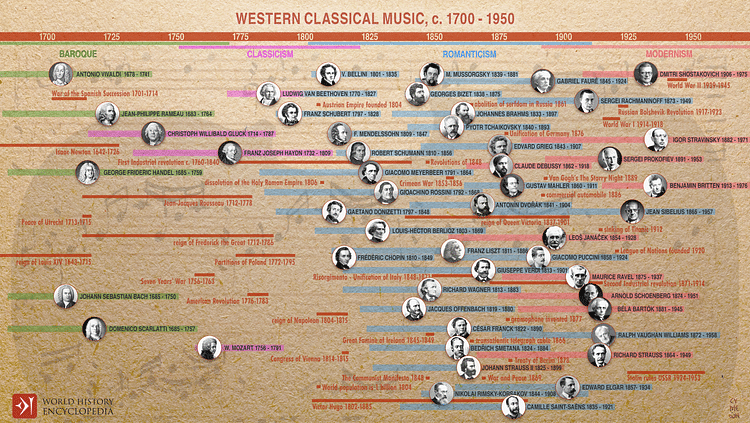
Debussy's Major Works
The most important works by Claude Debussy include:
Suite bergamasque – includes Clair de Lune (1890)
Prélude à L'après-midi d'un faune – Prelude to the Afternoon of a Faun symphonic poem (1892-4)
Pelléas et Mélisande opera (1893-1902)
String Quartet in G minor (1893)
Nocturnes orchestral work (1899)
La Mer – The Sea, symphonic sketch (1905)
Images: Rondes de primtemps orchestral set (1905-7)
Children's Corner piano suite (1908)
Preludes for piano (1910, 1913)
Khamma ballet (1911)
Jeux ballet (1913)
Death & Legacy
Debussy was diagnosed with cancer of the colon in 1914, but he had been suffering its effects for some years already. He continued composing, including En blanc et noir in 1915, which were three pieces for two pianos dedicated to three of his friends who had been killed in the ongoing First World War (1914-1918). He began working on six sonatas, but the set was never completed. Claude Debussy died on 25 March 1918 in Paris, his remains now lie in the Passy cemetery in Paris.

For many, Debussy set music free from conventional forms and showed the way for even more innovative modernist composers to follow, like Béla Bartók (1881-1945) and Olivier Messiaen (1908-1992). Igor Stravinsky's (1882-1971) Feu d'artifice, a 1908 orchestral fantasy, shows a strong influence of Debussy, while his 1921 Symphonies of Wind Instruments was dedicated to Debussy. Stravinksy once noted: "The musicians of my generation and I myself owe the most to Debussy" (Steen, 800). Maurice Ravel (1875-1937) was another admirer, and he arranged Debussy's Nocturnes for two pianos in 1909. As The Encyclopedia of Music succinctly puts it, "Debussy was one of the father figures of twentieth-century music" (Sadie, 349).
Still tremendously popular today, Debussy's music continues to fascinate with its unique preoccupation with what he himself called "the mysterious correspondence between Nature and Imagination" (Steen, 797). Concerned above all with tone, sonority, and mood, Debussy is "the musical painter and epigrammatist par excellence" (Schonberg, 532).
